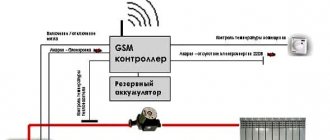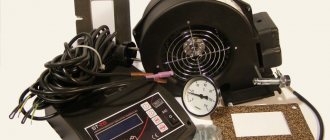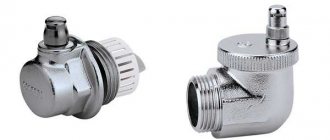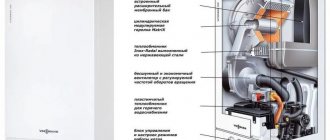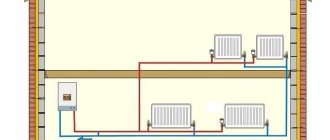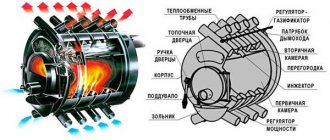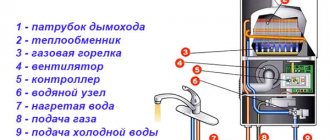A GSM controller is an electronic device designed for automatic and remote monitoring and control of any electrical equipment. The range of applications of the GSM controller is wide. This can be performing the functions of a simple GSM switch or GSM relay, controlling a barrier and gate, lighting, performing security functions, measuring the temperature of the environment. Separately, it is worth noting the possibility of advanced control of heating boilers. It is possible to control devices that have an input for connecting external (room) thermostats. The GSM controller is connected to the corresponding boiler input, and the temperature sensor is installed in a convenient place in the room. When the indicators change, the controller program reacts to this by changing the heating mode. The user can also receive notifications about changes in temperature and power parameters. You can start and stop the operation of connected equipment from a distance, and the GSM thermostat independently regulates the temperature mode.
Design and principle of operation of the GSM module for the boiler
In essence, the GSM module is a variation of a mobile phone, since it uses the same communication protocol.
The operating principle of the device is as follows:
- using a SIM card, the device connects to the GSM network;
- then it connects to the smartphone;
- You can send a signal to the device from the gadget;
- After receiving the signal, the module changes the boiler settings (raises or lowers the temperature, turns it on, off).
The module itself consists of the following structural elements:
- Thermostat . Controls the boiler temperature and sends a signal to the owner’s smartphone about its change. Many models allow you to use other notification methods (light, sound signals).
- Fasteners . Base for mounting the device. Typically designed for installation on a vertical wall.
- Power unit . The module elements are not designed to work with standard household voltage. Therefore they need a power supply. Typically the operating voltage of the device is 9 V or 12 V.
- Antenna . Allows you to receive signals in the GSM range, with the help of which the module is controlled.
- Sensor _ Determines the temperature of the boiler and transmits the received information to the thermostat for further processing and notification to the owner. Most sensors are capable of operating at temperatures from -50 o C to +99 o C. This allows them to be used in almost any conditions.
- Backup power supply . Represents a battery or accumulator. Designed in case of a power outage or power supply failure. Ensures long-term battery life of the device while maintaining full functionality.
Expert opinion
Grebnev Vadim Savelievich
Heating system installer
Another essential element of the GSM module for boiler control is the SIM card. After all, it is with the help of it that the device connects to the mobile network. But it will have to be purchased separately. Some manufacturers include a SIM card with a suitable tariff in the kit, but this is rare.
Operating modes
Most existing device models have two operating modes:
- Automatic . The owner of the device sets the necessary settings, and the device operates in accordance with them. For example, you can set the boiler to turn off when a certain temperature is reached and turn on again after cooling.
- Manual . In this case, control is carried out completely manually. A smartphone is used for this.
- Anxious . Essentially, this is the same automatic mode. But with one caveat - the system notifies the user in case of emergency situations (for example, an unexpected increase in temperature above permissible values or spontaneous shutdown of the boiler).
Some models allow you to combine modes. For example, you can enable manual control of the boiler and at the same time enable notifications about emergency situations.
Basic operating modes
There are several control modes; by choosing one of them you decide at what time and what information you will receive about the operation of the boiler:
- Auto. In this mode, the system operates according to the specified parameters. A complete analysis of the situation in the house and separately heated rooms takes place. At the specified time, you will receive a full report on the operation of the equipment.
- Manual (feedback from the user to the system). The essence of this mode is that users receive SMS messages with a code word to change a particular mode or adjust settings.
- Anxious. In the event of a power failure, smoke, leakage, unstable boiler operation and other emergency situations, you receive an instant notification.
What boilers does it work with?
Before purchasing a module, you need to find out whether the heating boiler supports the connection of such a device. Not all models have such support.
Autonomous systems with forced circulation of coolant (that is, equipped with a pump) are suitable for connecting the device. In this case, it is necessary to rework the safety system in order to prevent breakthroughs at the points where the module is connected.
Expert opinion
Grebnev Vadim Savelievich
Heating system installer
If the module has an air temperature sensor, then it can be used with other types of boilers. However, due to measuring t outside the system, it will work a little less accurately.
Features of operation in various types of boilers
The device has specific operation in different types of heating systems:
- When used in electric boilers, voltage monitoring is possible. The device can also signal a short circuit.
- When used with several boilers at the same time, the device can summarize information from them. This is relevant when used in production or in utility rooms.
- In pellet boilers using wood pellets, the module can regulate the fuel supply to the system.
When is a module needed?
A GSM module for controlling the boiler is required when the owner of the house is away for a long time, provided that it is necessary to maintain a certain temperature or turn on the heating in a timely manner.
The most common situations where this is necessary include the following:
- Long departure . The owner of the house goes on a business trip or vacation. In this case, you cannot completely turn off the heating - the system will freeze. At the same time, there is no one to operate the boiler at home.
- Cottage with heating system . If a heating system is installed in a country house, then when the boiler is turned off during the cold season, it will freeze. To prevent this, you can drain the system. But then it will be impossible to come to the dacha in winter because of the cold in the house. The solution to the problem is to remotely maintain a low positive temperature to prevent freezing using a GSM module.
What is included
The contents depend on the manufacturer and model of the product. The following parts are included as standard.
Controller (GSM module) is a device with a different number of inputs, expandable if you need to connect additional functions. Models in the low price segment contain a couple of standard functions and operating modes. More expensive devices have a pre-built control regulator for a week.
Portable temperature sensors, from two to ten - it depends on the type of module. Designed for different rooms, including outdoor ones. The optimal number is five, provided that one of them will be on the street.
Standard type of heat sensor (outdoor and room) for regulating temperature indicators in the entire house or in certain rooms
A GSM antenna is required to strengthen the signal. She is responsible for establishing uninterrupted communication with the owner of the equipment and with the towers of the cellular operator.
Through a relay (in most models up to 3 pcs.) feedback is provided to the owner. In the user manual for all modules there is a list of codes that characterize all normal and abnormal situations and codes for feedback.
Standard equipment of the gsm module using the example of the 4T model from . All components are connected and prepared for installation (+)
Additional sensors (such as motion and fire) are also required. More often, users independently purchase them depending on their needs.
The battery may be additionally present in some models. Manufacturers most often use lithium-ion. This is an important component because battery life depends on it. If the voltage is turned off, the power will automatically transfer to the battery.
The battery capacity should be enough for full operation of the GSM module for at least five hours, preferably up to two days. If you know that power outages occur frequently in your area, then it makes sense to purchase a battery with a larger capacity.
The master key prevents third parties from interfering with the heating system and removes the locks you have set.
Touch memory electronic key reader in the Xysal GSM module model. Used to protect against unauthorized intervention in boiler control
In addition, the kit includes an electronic key reader, a touch screen, connectors for connecting to the boiler, and coils of connecting wires. If necessary, you can purchase additional components or “assemble” the set to suit your needs.
How to choose a GSM module
When choosing a GSM module, you should pay attention to the following parameters:
- Ease of management . With a smartphone, everything is clear - the device is controlled using an application. But if the owner of the house, interaction with the device occurs in a different way. There are two most common control methods: physical buttons and touch screen. Models with the second option are more convenient (they show more information about the operation of the heating system). But they cost more. Of course, there are also models that are controlled exclusively from a smartphone. But you shouldn’t buy them - using such devices is not very convenient.
- Equipment . The basic delivery set of the module includes an antenna, an internal temperature sensor, fasteners and the device itself. But there are models with extended equipment. It may include external temperature sensors, gas detectors and other components. The kit is selected based on specific tasks. For example, if the goal is to ensure maximum safety, it is better to choose an option with a gas sensor. And if you just need to control the boiler remotely, the minimum configuration will do.
- Number of channels . The more there are, the more users can control the device. The cheapest models have two channels. But if there are three or four household members, this option is completely unsuitable. Therefore, the more people in the family, the more channels there should be on the module. It should be borne in mind that multi-channel devices will cost more.
- Backup battery capacity . The larger it is, the longer the device can work offline. You need to keep in mind that you should not overpay for a high-capacity battery where it is not needed. It is relevant only in the case when in the locality where the house is located, electricity is often cut off for a long time.
A GSM module for a boiler is a case where the quality of the device directly depends on the price. The higher the cost, the more powerful the processor (which means more settings can be set), the more convenient the control and the richer the equipment. Therefore, saving is always a compromise in relation to the comfort of using the device.
Remote controller functionality
The number of functions in any GSM module is limited and is determined by the following factors: the number of channels and, accordingly, sensors that can be connected through them, remote control features, as well as the ability to regulate heating indicators.
Basic and additional options
A standard set of sensors scans temperature, pressure and registers gas leaks; setting additional ones automatically enables new functions. Such sensors can be digital or analog. More often, manufacturers use analog ones, but this depends on the interface of the module itself.
The listed main functions guarantee uninterrupted and stable control of the heating system and implement the operating principles of the device:
- Switching the entire heating system on and off.
- Possibility to turn on/off, reboot the boiler or additional equipment.
- Remotely change the boiler operation settings, temperature intensity in the whole house or in a separate room, simply by sending an SMS with the required code. This will reduce gas consumption to 25-30%.
- Daily information via mobile messages about the state of the boiler, namely: notifications about operating parameters, temperature conditions, and, if necessary, about emergency situations, automatic shutdown of the device due to breakdowns.
- Using a pin code for the SIM card to avoid connection by third parties and any fraud.
- Prompt notification of an emergency shutdown of the heating system due to a fire, leak or any breakdown, if the owner has previously connected additional response sensors for them. The intelligent system, in the event of an emergency, takes steps itself. For example, in the event of a gas leak, the boiler or all equipment is turned off.
- Electrical voltage stability control - protection against sudden energy surges.
- Autonomous mode of operation of the controller - it is ensured by the presence of a battery. If the power goes out, the module will run on this battery. But remember that when the power is turned off, only the message sending function will work, since the boiler requires continuous current to operate.
- By reducing the heating load, the service life of the equipment increases.
Users set in advance the minimum and maximum permissible values of parameters (for example, temperature conditions). When the indicators go beyond the specified range, the owner receives an SMS message about this.
Some modern modifications of GSM modules can display statistics on boiler operation in the form of creating time graphs.
For the convenience of users, the module can “report via SMS” not only to the owner, but also to other family members. You can connect from 2 to 10 numbers, depending on the equipment model
If you are going abroad and roaming is expensive, then you can use one of the other numbers. In some module models, control via voice messages is available.
The functionality, even with standard equipment, is high. As a result, the user will be able to fully control the heating and other systems in his absence.
Additional functions are not fundamental when choosing a module, but they significantly simplify the life of owners:
- Possibility to connect an additional relay for new sensors.
- Launching additional equipment and the ability to control it using a cell phone from a distance.
- Pressure control function in a solid fuel boiler.
- Monitoring the level of diesel fuel if the boiler is using liquid fuel.
- Calculation of the quantity and quality of pellets in the compartment of a pellet heating unit.
- Checking the boiler feeder.
- Turn on the emergency siren.
If you install additional sensors, you will be able to perform the following functions:
- security of the premises in the presence of motion sensors (can be internal - for the house and external - for the site);
- the fire safety function is guaranteed by the smoke indicator - the user specifies the limit numbers in advance;
- flood warning - the leakage sensor will give a signal and shut off the water.
It is the various sensors and correct configuration of the module that guarantee that you will know exactly what is happening with all the controlled equipment.
Modes of equipment use
The selected control mode determines when and what information you will receive about the operation of the controlled equipment:
- Automatic , in which the system operates according to previously established parameters, analyzing information throughout the house or in individual heated rooms. You receive a report on the heating operation at a specified time.
- Manual (feedback from the user to the system) involves the user sending a message with a code word or making a call to change certain settings or modes. For example, you want to know the temperature in a certain room or increase it to warm up the entire house.
- Anxious . If there is a power failure, smoke, a leak, gas surges, incorrect operation of equipment (the boiler stops working due to some kind of breakdown), then you will promptly receive a message about the breakdown.
In the latter situation, the module can block the damaged element or turn off the entire system. In addition, during an accident, alarm SMS messages are sent to all previously specified numbers.
A sample report in a mobile phone program about the life of the boiler when the standard mode is activated (indicated by the user as “0”)
All three modes are available in standard modules, but it is important to configure their operation correctly when installing the system.
How to connect the module yourself
The algorithm for connecting the module to the boiler is always approximately the same. The model of the device does not matter at all.
To connect the device, you must:
- de-energize the boiler;
- remove the casing;
- connect or solder the module wires to the boiler board in accordance with the instructions;
- install a SIM card, antenna, sensors;
- put back the boiler casing;
- turn on the module and synchronize it with your smartphone;
- restore power supply.
The best models of GSM modules for remote control of heating boilers
Let's look at several current device models available for purchase today.
KotelOK 2.0
A simple, inexpensive and reliable model made in Russia. The cost of the product varies from 5,000 to 6,500 rubles.
Consists of the following components:
- GSM unit with antenna;
- control Panel;
- sensor.
The control panel has a wide monochrome display and four setting buttons. A good GSM antenna provides good signal quality.
The main disadvantage of the device:
- control using SMS commands (no application). This is not very convenient.
The main advantage of KotelOK 2.0:
- possibility of fine adjustment of the temperature of the heating system. It can be changed down to 0.1 o C.
Telemetrics 3
Compact and convenient GSM module. It has a large and most informative monochrome liquid crystal display. Control is carried out using three physical buttons located under the screen.
- The main advantage of the device
Versatility. It can be connected not only to the boiler, but also to any other device (for example, an air conditioner).
- Minus
Lack of complete outdoor antenna. Of course, third-party installation is possible. But these are additional costs. Which are completely inappropriate given the high price of the device (about 9,000 - 10,000 rubles).
Optima-1 Heat monitor
A simple, reliable and easy-to-use device. It consists of a pair of thermostat - GSM module. Able to work with several boilers simultaneously. It is also possible to connect to an alarm system.
Programming is provided for the next seven days for use in automatic mode. There is frost protection, which allows the model to be used in subzero temperatures.
Thanks to the presence of an external antenna in the kit, stable signal reception from the owner’s smartphone is ensured with almost complete absence of interruptions.
- The main disadvantage of the device
Insufficiently informative interface. There is no display here. Instead, indicator LEDs are used. It is clear that it is difficult to reflect all the necessary information with their help.
The cost of the device is from 8,500 to 9,000 rubles.
Popular models according to user ratings
The list includes popular models on the Russian market with the optimal combination of price and quality:
- Xital GSM with modifications 4T, 8T and 12T - the numbers indicate the number of zones/rooms that can be controlled. The device is suitable for any boiler, the cost is from 8 to 10 thousand rubles.
- Sapsan Pro 6 for any boiler equipment, you can link up to 10 numbers. Cost from 10 to 16,500 rubles.
- Telcom 2 only for De Dietrich, allows connection of up to 5 numbers.
- The GSM module from Teplocom is suitable for any heating system and requires minimal settings. They ask from 6,000 rubles.
- Vitocom 100 only for Viessmann, a maximum of two numbers can be connected. The price varies from 26 to 30 thousand rubles.
- Logomatic PRO GSM only for Buderus (more often used for floor-standing boilers), the maximum number of numbers is 16. This model will cost 30,000 rubles.
When choosing, focus on how much equipment you want to control, what power it is, what additional indicators you want to connect and the characteristics of the thermal regime in the room.
